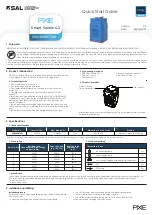
Introduction to DHCP Server
127
DHCP Packet Processing
Modes
■
Global address pool: In response to the DHCP packets received from DHCP clients,
the DHCP server picks IP addresses from its global address pools and assigns them
to the DHCP clients.
■
Interface address pool: In response to the DHCP packets received from DHCP
clients, the DHCP server picks IP addresses from the interface-based address pools
and assigns them to the DHCP clients.
■
Trunk: DHCP packets received from DHCP clients are forwarded to an external
DHCP server, which in turn assigns IP addresses to the DHCP clients.
You can specify the mode to process DHCP packets. Note that an interface can
operate in only one mode at a given time; and a newly configured mode overwrites
the existing mode.
This chapter covers the configuration of the first two modes. The configuration of the
trunk mode is covered in Chapter 3 "DHCP Relay Configuration".
DHCP Address Pool
A DHCP address pool holds the IP addresses to be assigned to DHCP clients. When a
DHCP server receives a DHCP request from a DHCP client, it selects an address pool
depending on the configuration, picks an IP address from the pool and sends the IP
address and other related parameters (such as the IP address of the DNS server, and
the lease time of the IP address) to the DHCP client. You can configure multiple
address pools for one DHCP server. Currently, a DHCP server supports up to 128
global address pools.
Types of address pool
The address pools of a DHCP server fall into two types: global address pool and
interface address pool.
■
A global address pool is created by executing the dhcp server ip-pool command in
system view. It is valid on the current device.
■
If an interface is configured with a valid unicast IP address, you can create an
interface-based address pool for the interface by executing the dhcp select
interface command in interface view. The IP addresses an interface address pool
holds belong to the network segment the interface resides in and are available to
the interface only.
The structure of an address pool
The address pools of a DHCP server are hierarchically organized in a tree-like
structure. The root holds the IP address of the network segment, the branches hold
the subnet IP addresses, and the leaves holds the IP addresses that are manually
bound to specific clients. The address pools that are of the same level are sorted by
their configuration precedence order. Such a structure enables configurations to be
inherited. That is, the configurations of the network segment can be inherited by its
subnets, whose configurations in turn can be inherited by their client address. So, for
the parameters that are common to the whole network segment or some subnets
Summary of Contents for 5500 SI - Switch - Stackable
Page 24: ...24 ABOUT THIS GUIDE...
Page 50: ...50 CHAPTER 1 GETTING STARTED...
Page 54: ...54 CHAPTER 2 ADDRESS MANAGEMENT CONFIGURATION...
Page 78: ...78 CHAPTER 3 PORT OPERATION...
Page 88: ...88 CHAPTER 4 XRN CONFIGURATION...
Page 122: ...122 CHAPTER 8 VLAN VPN CONFIGURATION...
Page 216: ...216 CHAPTER 15 SSH TERMINAL SERVICES...
Page 268: ...268 CHAPTER 16 IP ROUTING PROTOCOL OPERATION...
Page 308: ...308 CHAPTER 17 NETWORK PROTOCOL OPERATION...
Page 349: ...349...
Page 350: ...350 CHAPTER 18 MULTICAST PROTOCOL...
Page 522: ...522 CHAPTER 22 FILE SYSTEM MANAGEMENT...
Page 584: ...584 CHAPTER 30 PASSWORD CONTROL CONFIGURATION OPERATIONS...
Page 600: ...600 CHAPTER 31 MSDP CONFIGURATION...
Page 614: ...614 CHAPTER 32 CLUSTERING...
Page 670: ...670 CHAPTER C AUTHENTICATING THE SWITCH 5500 WITH CISCO SECURE ACS...
















































